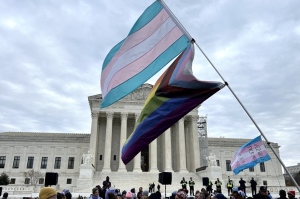Revelation 16: A world shaken and pummeled to the ground

Within the sacred pages of Revelation chapter 16, the reader encounters a compelling portrayal of God’s incomparable power, the gravity of human defiance, the somber consequences of rebellion, and God’s unswerving commitment to truth and holiness.
As seven angels pour out seven bowls, the narrative unfolds with powerful and evocative imagery of the affliction of grievous sores, oceans and rivers lethally polluted, scorching heat from the sun, darkness that falls which is so dense it can be felt, and the Great River Euphrates dries to make a way for demonically inspired armies to gather at Armageddon for the greatest war in human history.
This chapter is a poignant call to repentance, a stark reminder of the consequences of unrepentant sin, and a testament to the imminence of God’s ultimate triumph over the forces of evil.
Starting with verse 17, a seventh angel pours out the seventh and last bowl of wrath. This is what the Scriptures say happens:
“Then the seventh angel poured out his bowl into the air. And a mighty shout came from the throne in the Temple, saying, “It is finished!” Then the thunder crashed and rolled, and lightning flashed. And a great earthquake struck — the worst since people were placed on the earth. The great city of Babylon split into three sections, and the cities of many nations fell into heaps of rubble. So, God remembered all of Babylon’s sins, and he made her drink the cup that was filled with the wine of his fierce wrath. And every island disappeared, and all the mountains were leveled. There was a terrible hailstorm, and hailstones weighing as much as 75 pounds fell from the sky onto the people below. They cursed God because of the terrible plague of the hailstorm” (Revelation 16:17-21).
The seventh angel pours out the contents of its bowl into the air. In the apostle Paul’s letter to the church at Ephesus, he says that before their conversion to Christ, they were dead in their sins. They followed this world’s value system and the ruler of the kingdom of the air (Ephesians 2:2), which is a reference to Satan and his domain. In the same letter, the apostle admonishes them, “Our fight is not with people. It is against the leaders and the powers and the spirits of darkness in this world. It is against the demon world that works in the heavens” (Ephesians 6:12). Therefore, it may be deduced from this that the seventh angel is in some way emptying his bowl on the air, on the atmosphere, on the heavens, on the very headquarters from whence the Evil One and his devils work.
There are many today who scoff and laugh at the idea of a personal devil and demons. But the Bible is full of passages that confirm their reality.
For example, in the Gospels, Jesus engages in direct confrontations with Satan during his temptation in the wilderness (Matthew 4:1-11, Luke 4:1-13). Jesus’ casting out of demons is a recurring theme in the New Testament (The Healing of the Gadarene Demoniacs — Matthew 8:28-34; A Mute Man with a Demon — Matthew 9:32-34;The Syrophoenician Woman’s Faith — Matthew 15:21-28;The Healing of a Boy with a Demon —Matthew 17:14-21;Jesus’ Authority Demonstrated in the Synagogue — Mark 1:21-28;The Healing of the Demon-Possessed Man of the Gerasenes — Mark 5:1-20).
If the Bible is true in what it says about Jesus, then it is true about the devil and demons, too. Moreover, if it is true as the apostle Paul says in Romans 1:19-20, that God’s existence is inferred from the observation of the natural world, in a similar manner the devil’s existence is inferred by examining the world and the wicked influences attributed to him.
It is much the same way a lawyer would use circumstantial evidence to prove a case in court. The presence of evil and negative influences, as well as the idea that the devil can influence human behavior, are presented as strong evidence for the reality of the devil and demons.
Once the bowl is voided a mighty shout comes from the throne in the Temple, declaring, “It is finished.”
Remember Jesus declared, “It is finished” on the cross (John 19:30). What Jesus had done by his blood-atonement on Calvary’s tree purchased redemption in full. It was a finished work, but it had ongoing benefits for everyone who believes.
However, when the last bowl is dispensed and the Lord speaks these words from the Temple, it means the work of judgment on this God-hating, unbelieving, pervasively dark world of doubt and indifference, where the cacophony of skepticism constantly drowns out the Spirit’s whispers of hope, is completed and done. And, in this case, there are no benefits, none whatsoever for those who reject the Savior.
In an instant, deafening thunder is said to have reverberated through the air, accompanied by brilliant, flashing lightning. This has happened before.
In Exodus 19:16-19, when God descended upon Mount Sinai to deliver the Ten Commandments to Moses, there was thunder, lightning, and a dense cloud came down on the mountain. The people trembled at the display of God’s power. In 1 Kings 18:38, during Elijah’s showdown with the prophets of Baal on Mount Carmel, God sent fire (lightning) from Heaven to consume Elijah’s offering, accompanied by thunder and rain, demonstrating his supremacy. In Revelation 4:5 and Revelation 8:5, thunder and lightning occurred as a part of John’s heavenly visions, emphasizing the awe-inspiring nature of God’s divine revelation.
The thunder and lightning are impressive symbols of God’s majesty, authority, and presence, leaving a profound impact on those who witness them.
The Psalmist says, “Who can be compared with the Lord our God, who is enthroned on high? He stoops to look down on Heaven and on earth … Let the whole world fear the Lord, and let everyone stand in awe of him … Worship the Lord in all his holy splendor. Let all the earth tremble before him” (Psalm 113:5-6; 33:8; 96:9).
Yet more, a colossal earthquake strikes, “the worst since people were placed on the earth” (vs. 18).
Earthquakes, as recorded in Scripture, serve as potent manifestations of God’s presence, judgment, deliverance, or significance, illustrating God’s authority over the natural world and his involvement in human history.
The prophet Haggai recorded the Lord saying, “In just a little while I will again shake the heavens and the earth, the oceans and the dry land. I will shake all the nations…” (Haggai 2:6-7).
Earthquakes accompany very significant events such as when God descended on Mount Sinai to give the Ten Commandments, and the mountain quaked (Exodus 19:18). An earthquake also occurred at the crucifixion of Jesus, signifying the solemnity of his sacrifice, which inaugurated a new covenant of grace and faith (Matthew 27:51-54). There was also an earthquake at the resurrection when the angel rolled away the great stone from the tomb, which marked God’s approval and acceptance of Christ’s sacrifice (Matthew 28:2).
The three worst earthquakes in world history were:
1. The Jiajing Earthquake (1556), which struck Shaanxi, China, was the deadliest. It claimed approximately 830,000 lives. It was estimated to have been around 8.0 to 8.3 on the Richter Scale.
2. The Tangshan Earthquake (1976), happened in Tangshan, China, and resulted in the deaths of an estimated 242,000 people. It also caused extensive damage to buildings and infrastructure. Its magnitude was approximately 7.5 on the Richter Scale.
3. The Indian Ocean Earthquake and Tsunami (2004), was an undersea earthquake off the coast of Sumatra, Indonesia. It triggered a massive tsunami that affected several countries around the Indian Ocean, resulting in over 230,000 fatalities and widespread destruction. It was estimated to be between 9.1 and 9.3 on the Richter Scale.
However, the earthquake foretold in Revelation 16:18 is unlike any earthquake that has ever shaken the earth before. The world’s worst earthquakes will only seem like a tremor compared to the one predicted in this passage.
How bad will it be? It will split the great city of Babylon in three different ways, but Babylon at this point, will not be entirely destroyed. Daymond R. Duck and Larry Richards in The Book of Revelation: The Smart Guide to the Bible Series, contend:
“This great earthquake will split the great city of Babylon into three parts, but it will stand. This cannot be said for other cities because they will be leveled. Every city on earth, except Babylon, will be in ruins as the end of the Tribulation Period approaches. With Babylon still standing, it will come into remembrance before God. One of the three angels (Revelation 14:8) predicted Babylon’s doom just a short time before this. The Old Testament prophets predicted her doom long before that. It will be time for those prophecies to be fulfilled. She will get the cup filled with the wine of the fury of his wrath.”
Many people remember the classic Etch-A-Sketch. This nostalgic toy has entertained kids and adults for decades. I used to play with one when I was a boy. It consists of a red plastic frame with a gray screen, and inside is a mixture of aluminum powder. To create a drawing, you simply turn two white knobs on the right and left on the front of the frame, which are connected to a stylus inside. As you turn the knobs, the stylus moves through the aluminum powder, presenting dark lines on the gray screen. If you want to start over, you simply shake the Etch-A-Sketch, and all the lines will fall and erase your drawing.
Imagine the world as an enormous Etch-A-Sketch. Just like when you shake the Etch-A-Sketch and all the lines fall and disappear, in Revelation 16:20, God’s mighty power shakes the earth so profoundly that it’s as if every island and mountain on this “Etch-A-Sketch world” disappears. The familiar landscapes and features we know are completely transformed, just as the Etch-A-Sketch starts fresh with a clean slate when you shake it. This dramatic event, this unprecedented earthquake, signifies the incredible power and sovereignty of God in reshaping the world and preparing it for his purposes. It’s a forceful symbol of the profound changes and divine renewal that will take place during this momentous time in biblical prophecy.
The prophet Isaiah has written of this moment, saying:
“Destruction falls like rain from the heavens; the foundations of the earth shake. The earth has broken up. It has utterly collapsed; it is violently shaken. The earth staggers like a drunk. It trembles like a tent in a storm. It falls and will not rise again, for the guilt of its rebellion is very heavy” (Isaiah 24:18-20).
When the Twin Towers of the World Trade Center in New York City were struck by commercial airliners, they swayed and tilted, somewhat like a drunkard does before falling. The impact of the planes and the subsequent fires weakened the structural integrity of the buildings, causing them to sway and lean before eventually collapsing catastrophically.
At the end of the Tribulation, God shakes this rebellious planet with an earthquake so massive entire cities, even the largest and most prosperous, such as New York, Tokyo, Shanghai, Mumbai (formerly Bombay), Mexico City, Cairo, and London, will tumble to the ground as the Twin Towers did on September 11, 2001.
Duck and Richards note:
“This seems hard to believe, but the 2004 Sumatra earthquake [Indian Ocean Earthquake and Tsunami] that killed more than 280,00 people moved islands and caused the earth to tilt on its axis. Some islands temporarily disappeared under a thirty-foot-high wall of water.”
Still, there remains one final cataclysmic event of biblical proportions, an event that will serve as the climax of this apocalyptic narrative in Revelation chapter 16. A hailstorm of unparalleled magnitude descends upon the earth, its scale eclipsing any previous meteorological event.
Hailstorms have had devastating consequences, causing loss of life, destruction of property, and significant economic impacts. The seventh plague in Egypt involved a devastating hailstorm. Hail and thunder, along with fire, rained down upon the land, causing unprecedented destruction (Exodus 9:22-26).
The renowned Bible commentator, Matthew Henry, describes what the hailstorm in Egypt did to them:
“What desolations it made upon the earth. It killed both men and cattle and battered down, not only the herbs but the trees. The corn that was above ground was destroyed, and that only preserved which as yet had not come up.”
In other words, the hailstorm that pummeled the Egyptians was not only a deadly disaster, but it crushed the nation’s economy.
Some scholars and scientists have attempted to offer natural explanations for certain biblical events, such as suggesting a volcanic eruption might have caused the hailstorm in Egypt, just as some suggest the hailstorm in Revelation 16:21 might be precipitated by a nuclear war.
In The Book of Revelation, Edward Hinson, Dean of the Institute of Biblical Studies at Liberty University, writes:
“It is certainly possible that these judgments are cosmic (an asteroid collides with earth) or geological (volcanos and earthquakes). But the clear references to men fighting, armies marching, and fire falling certainly sound like a great world war involving nuclear weapons. How ironic that John locates this last great conflict between the forces of God and Satan at Armageddon, near Mount Carmel where Elijah stood against the prophets of Baal and called down the fire of God in a demonstration of his mighty power.”
Whatever the cause, the Scriptures make it abundantly clear that this event is providential, guided, and directed by the hand of God. At the root of it, is God’s fierce and unrelenting anger. This is why speculation about natural causes is not part of the biblical narrative.
One of the deadliest hailstorms ever recorded happened in Gopalganj, Bangladesh in 1986. It killed at least 92 people and injured over 500. The hailstones also extensively damaged crops, livestock, and property. The hailstones were said to be the size of oranges.
Nevertheless, according to Revelation 16:21, each hailstone that falls to the earth because of the seventh outpouring of God’s bowls of wrath is said to weigh about “75 pounds.”
No question, whatever the earthquake didn’t shake down, the hailstorm will beat down.
It’s interesting that after the horrific hailstorm that occurred in Egypt, Pharoah humbled himself and spoke the language of a penitent man. He “quickly summoned Moses and Aaron. ‘This time I have sinned,’ he confessed. ‘The Lord is the righteous one, and my people and I are wrong. Please beg the Lord to end this terrifying thunder and hail’” (Exodus 9:27). He even set the Israelites free. Yet, Pharoah later changed his mind and repented of his repentance and sought to chase down and recapture his former slaves.
After the seventh bowl is emptied, those who survive will stand amidst the debris, their lives having been shaken asunder, their spirits tested by the fury of frozen missiles, if they show any remorse, if they should weep and blame themselves, if they should look toward heaven and beg God for mercy, it will not last. Like a dog that turns back to eat its own vomit, they will repent of their repentance and curse God.
Dr. Chuck Missler in his commentary handbook on The Book of Revelation provides an excellent closing. He writes:
“Many are trying to reduce the population of the earth; it seems more appropriate to reduce the population of hell! God changes hearts through his grace and mercy. This book was sent to the seven churches. It was given to us in order to change our lives right now!”
Be saved. Be forgiven. Be changed by Christ, right now!
Rev. Mark H. Creech is Executive Director of the Christian Action League of North Carolina, Inc. He was a pastor for twenty years before taking this position, having served five different Southern Baptist churches in North Carolina and one Independent Baptist in upstate New York.




























